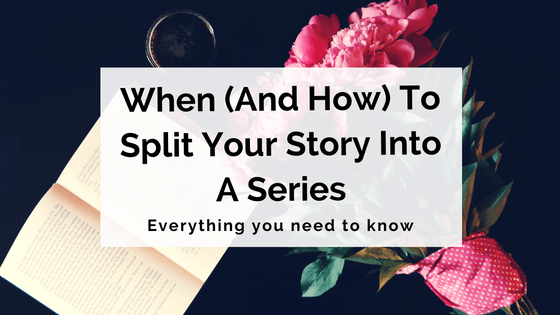You’ve been working away at your novel, lovingly crafting each word, and the thought occurs to you: should I split this into another book or two? Often this thought comes up when you glance at your word length, steadily increasing beyond your expectations.

Splitting or expanding your novel into a series is a big step. You want to be sure it’s the right thing for your story, and be sure that you do it well. If you’re struggling with either of these, read on!
Table Of Contents
How do I know whether my story should be a series?
Before you jump right in and start converting your novel into a series, take a moment to consider whether it’s the right choice. Here are a few guidelines to help you make your decision.
Trust your instinct
The most important factor in deciding whether your story should be a standalone or series is your inner writer voice. Sometimes stories lean towards one format over another. It’s up to you to listen to your story and trust your instinct.
…chances are we’re capable of better than what we’ve done. That nagging little feeling—that instinct—is our brain’s way of trying to convince us of that.” — Harrison Demchick
However, the best format for some stories can be difficult to discern. When your writer vibes only give you a hazy answer, it’s time to look elsewhere to make the decision.

Know your book’s market
Writers often ask themselves, ‘Is my story too long? Should I split it into another book?’ The place to check is the shelf your story would one day sit on.
Different types of stories have different expected word lengths, and your story will be easier to sell if you conform with the typical dimensions. Having said that, if your book’s market says one thing and your author’s instinct says another, follow your instinct.
Define your genre
Genre is an important category system for books, and if you’re serious about writing you’ll need to be familiar with navigating genres and subgenres.
To identify your genre, look at your main conflict. Side-plots are largely irrelevant, unless they contain key tropes such as magic — which should exist in the main plot anyway.
Just because your hero falls in love while battling the kingdom of darkness, that doesn’t make your story a romance. Unless falling in love is the focus of the story, and the central feature of the climax, epic fantasy seems to be the genre here – not romance.
Classifying a book by genre signals to potential readers whether your story fits their reading interests. When a book has an identifiable genre, publishers can also market it to the right readers more effectively.” — Bridget McNulty
Your story will likely borrow bits from other genres, but what’s important when defining your genre is to keep coming back to your main plot, your core conflict.
Sometimes no matter how hard you try, you just can’t get your story to fit in one genre. It keeps leaning into another. That’s fine; stories can be cross-genre. If you’re in that situation, look for other books with the same genre mix or investigate both genres.
Compare your story’s length to others in the same genre
Different genres have different word lengths associated with them. Fantasy books, for example, are known for their length, while humour books are often on the small side.
Have a search online, or physically go into your local bookstore and check the shelf of your book’s genre. What is the length of those books? If your manuscript is significantly larger than the books you look at, it might be time to consider splitting it into a series.
When checking word count, don’t be too concerned about sub-genres. You wouldn’t need to determine the average word length of a paranormal romance — just romance in general is sufficient.
A quick guide to genre word counts
Below is a list of the average or expected word length for adult fiction novels of various genres. If your story sits between more than one genre, average their word lengths out and use that for your general aim.
- Crime/Horror: 70,000–90,000
- Drama: 80,000–100,000
- Historical: ~100,000
- Literary: 80,000–100,000
- Romance: 50,000–100,000
- Satire and Humour: 40,000–60,000
- Speculative (Fantasy, Science Fiction, etc): 90,000–120,000
Find the standalone-series ratio in your genre
Check also how often books of your genre are standalone, and how often they are part of a series. And if they are a series, check what type. For example, a crime series is often episodic in nature.

Consider the age of your target audience
As well as genre, there is anther big consideration to help you decide whether your story is too long and should be split into a series: your audience’s age.
Unsurprisingly, the younger the targeted reader, the shorter the novel. This is due mostly to education levels and attention spans, and so word count limits for age are stricter than those for genre.
Below is a list of the average or expected word length of fiction books for various ages. Bear in mind to also check the genre word lengths. While the quick list provided in the genre section is for adult books, you can use the adult figures as a general ratio.
- Picture Books: >1,000
- Younger readers (ages 5–7): 8,000–12,000
- Junior (ages 8–12): 20,000–35,000
- Young adult: 45,000–80,000
- Adult: 80,000–100,000

How do I turn my story into a series?
So, you’ve decided that your lovingly crafted words are best split into more than one book. Now what?
Splitting a story into more books than you initially planned is a big step. Here are a few tips on how to transform your story successfully into a series.
Make each book stand alone
When dealing with a series, you still want each book to be able to stand on its own.
As you polish that first book, make sure that it has its own theme, that its climax leaves room for the series to build, and that its ending is satisfying.” — Chris Winkle
Of course, the series also needs to flow together, so you want overarching plots and themes to stretch across all books. However, each book you split your story into needs to contain a full story — or, more accurately, a full part of the larger story.
How do you do that? The most important feature to look at is your plot, but character development also affects how your readers interact with your series. Let’s take a look at each of these in more detail.

Don’t leave the plot hanging
Each book must have a complete plot of its own, otherwise readers may feel cheated or unsatisfied at the end of each book. This then runs the risk that they won’t pick up the next book.
Now, what exactly is meant by a ‘complete plot’? The best way to understand plot is to research various plot structures, such as The Hero’s Journey or the Eight-Point Arc.
Taking from the commonly-used Three-Act Structure, a plot basically comprises of an inciting incident, a climax and a resolution. In other words, while the whole series has a meta-conflict, each book should solve separate conflicts or problems, which connect towards the meta-conflict.
…readers should feel that the end was inevitable and that you fulfilled your part of the writer/reader contract by providing a satisfactory and logical resolution for the situation and the characters you created.” —Beth Hill
For example, the meta-conflict of Harry Potter is Harry defeating Voldemort. But in each book there is a specific task or threat that Harry must face, in order to ultimately be successful in the meta-conflict. He also faces several mini-conflicts in each book, some which carry over to other books, others which don’t.
The important points are the meta-plot (the series) and the main plot (the book). If you haven’t already invested time in planning your novel by creating plot outlines or other overview systems, they are especially helpful when managing the intertwining, yet separate, plots of a series and its books.
Find the perfect point to split your plot
Your story should be full of ups and downs, triumphs and trials. One of the best places to cut a plot into separate books is shortly after a significant triumph. This should give your book the climax and resolution ending to make it feel like a complete, standalone plot. It’s that simple!
Unfortunately, though, not all stories have a nice little climax-resolution around the word count you want to split the story at. You could add more sub-plots and mini-conflicts to push the climax-resolution a few pages back. But be careful not to add irrelevant or uninteresting events just to bulk out your story.
Making that first section into its own book could mean completely redoing the plot.” — Chris Winkle
Another solution is to create a new significant conflict with a climax-resolution point where you want to split. This will require you to carefully weave the new conflict through all the writing you’ve already done.
The reality is, if a convenient point to split your plot doesn’t exist, you’ve got a fair bit of work to do. The point at which you split your story is very important. You’re much more likely to lose readers between books than in the middle of one, so don’t split your story halfheartedly.
Use cliffhangers wisely
But, you may say, wouldn’t leaving the story hanging encourage readers to pick up the next book? Yes, it will, but readers may often feel unsatisfied without some sort of triumph, achievement or resolution.
However, just because your characters have had some sort of success, it doesn’t mean the story is over. What plot points for sequel books have you alluded to? Remind your reader of the questions that remain unanswered.
Readers don’t appreciate feeling frustrated and dissatisfied. They want to know all the work they’ve put into reading your book was worthwhile.” —Dara Beevas
Alternatively, give a little twist at the end of a book. During the book’s climax or resolution, have a character discover something that makes them realise that their goal or problem is bigger than they thought it was.

Make sure your characters are compelling
Generally speaking, twenty-first century readers are captured by characters more than plot or setting. If you haven’t developed your characters enough in the first book, readers may not follow onto the next book.
Making characters compelling is a big enough task to be an article on its own. Fortunately you don’t have to go far — Writer’s Edit already has many articles to help you polish up your characters! Be sure to check out:
- Easy And Effective Ways To Make Your Characters More Memorable
- How To Be An Expert On Your Characters
- 5 Quick Tips For Crafting Believable Characters
- 8 Secrets To Writing Strong Character Relationships
- The Ultimate Guide To Creating An Authentic Villain
Creating authentic, compelling characters who grow and develop over the course of multiple books is a surefire way to write a successful series.

* * *
There’s no right or wrong answer when deciding whether or not to make your story a standalone or series. However, particularly if you’re working on your debut, it doesn’t hurt to keep the industry standards and expectations in mind.
Once you’ve decided, be sure to check out The Essential Guide for Writing a Series vs. a Standalone Novel for extra details on considerations such as publishing and marketing.
As long as you stay true to your writer instinct and keep an eye on plot and character, you can feel confident bringing your story into the world in either format.